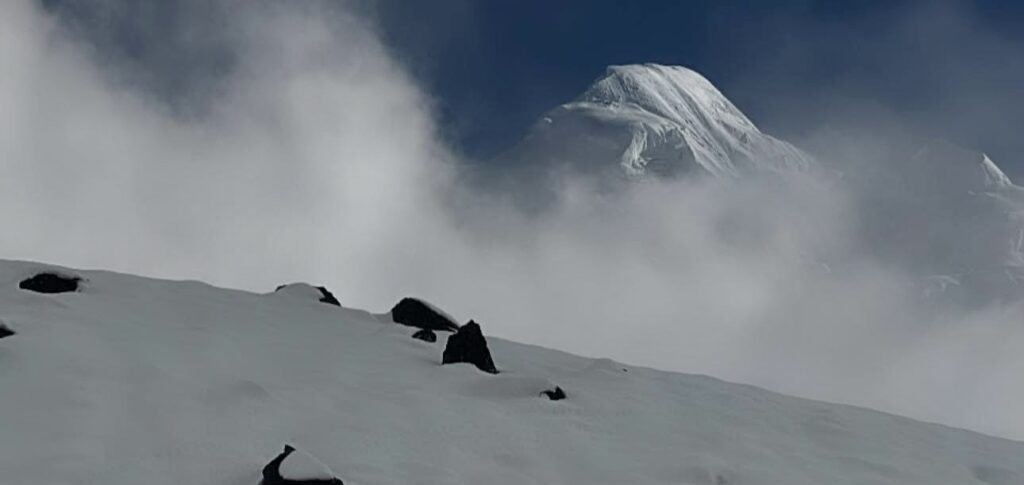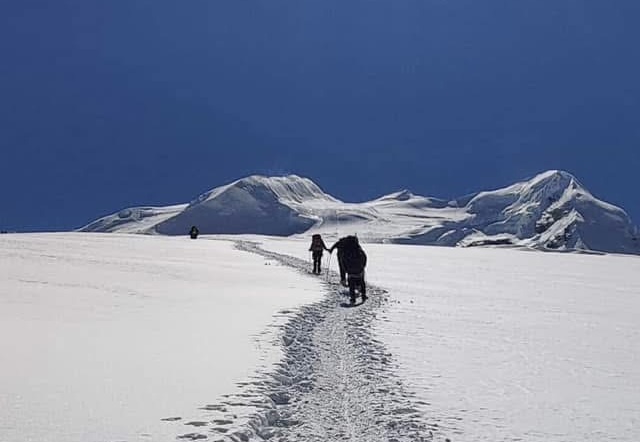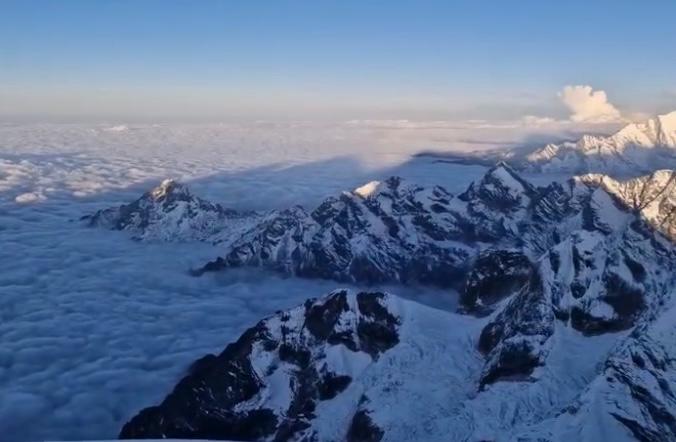Mera Peak climbing
Be the first to review!
Overview
Embark on the ultimate Mera Peak climbing adventure in Nepal’s Everest region — experience breathtaking Himalayan views, thrilling trekking, and a rewarding summit!
Mera Peak climbing takes you on an unforgettable journey to one of Nepal’s highest peaks, nestled in the stunning Hinku Valley. This adventure combines the thrill of mountaineering with the beauty of trekking, all set in the captivating eastern Everest region, far from the typical tourist trails. The climb itself features a blend of picturesque trekking paths and technical challenges that test your skills. Renowned for its rich biodiversity, showcasing vibrant rhododendron forests, alpine vegetation, and diverse wildlife, all while steeped in the culture of the Sherpa communities, which adds a unique touch to your experience.
As you trek and ascend, you’ll be treated to breathtaking panoramic views of five of the world’s tallest peaks, including Everest, Lhotse, Makalu, Cho Oyu, and Kanchenjunga. The combination of natural beauty, physical challenges, and cultural immersion makes this journey truly unforgettable. Mera Peak is generally considered a non-technical climb, making it accessible for those looking to summit a Himalayan peak without requiring advanced mountaineering skills.
Highlights
– Breathtaking panoramic views of the towering Himalayan giants, including Everest and Makalu, from the summit.
– Opportunities for meaningful cultural interactions with local communities.
– An acclimatization day at Khare to help you adjust to the altitude before tackling the summit.
– Trekking through remote areas, far from the crowds.
Duration, Difficulty, Accommodation & Essentials
The trek spans 16 days, including arrival and departure. While the trek is classified as moderate, the altitude and summit climb can pose challenges, requiring good physical fitness and some prior experience at high altitudes. The summit attempt includes glacier travel, so basic skills with an ice axe and crampons are necessary. However, beginners can also participate with the right guidance and training with a qualified guide and proper acclimatization.
Accommodation:
– Tea houses and lodges with basic amenities along the route from Paiya to Lukla.
– Simple huts or camping at high-altitude camps, like Khare and Mera High Camp.
Permits Needed:
– TIMS (Trekkers’ Information Management System) card.
– Mera Peak Climbing Permit (issued by the Nepal Mountaineering Association).
– An Entry Permit for Sagarmatha National Park may also be necessary.
Why Choose This Destination
Mera Peak stands out as one of the highest trekking peaks in Nepal, offering a summit that is achievable for adventure seekers eager for a Himalayan peak experience. It’s perfect for trekkers who want to enjoy the journey and the thrill of reaching a summit without facing extreme technical difficulties. The summit not only provides stunning views of several Himalayan giants in one sweeping panorama but also allows for a deeper exploration of trekking, mountaineering, and cultural interaction. This experience is ideal for those looking to acquire basic mountaineering skills in a safe environment, accompanied by professional guides. With carefully curated non-technical climbing routes and fixed ropes, your safety is prioritized, making this an excellent introduction to Himalayan mountaineering.
Start your unforgettable Mera Peak journey today — book with expert guides and conquer one of Nepal’s highest trekking peaks safely and confidently!
✅ What's Included:
-
Arrival and departure transfers in Kathmandu
-
Domestic flight Kathmandu → Lukla and Lukla → Kathmandu
-
Accommodation in Kathmandu (before and after the trek)
-
Accommodation during the trek (teahouses/lodges)
-
Meals during trekking (breakfast, lunch, dinner)
-
Experienced trekking guide and climbing guide for Mera Peak
-
Porters for carrying luggage (shared)
-
Climbing permits and trekking permits (including National Park entry)
-
All ground transportation related to the trek
-
Basic first aid kit and oxygen cylinder for emergencies
-
Support staff wages and insurance
❌ Price Excludes:
-
International airfare to/from Kathmandu
-
Nepal visa fees
-
Personal climbing equipment (ice axe, crampons, harness, helmet, etc.)
-
Personal trekking gear (boots, jackets, sleeping bags, etc.)
-
Travel and rescue insurance (strongly recommended)
-
Tips for guides, porters, and staff
-
Drinks and snacks outside of meals
-
Personal expenses (laundry, phone calls, internet, souvenirs)
-
Any hotel accommodation or meals outside the itinerary (e.g., Kathmandu city tours)
Itinerary Overview
Day 1: Arrival in Kathmandu [1,330m]
Day 2: Flight from Kathmandu to Lukla (2840m) then Trek to Paiya [2,730m]
Day 3: Trek from Paiya to Pangom [2,846m]
Day 4: Trek from Pangoma to Nagindingma [2,650m]
Day 5: Trek from Nagindingma to Khola Kharka [3,930m]
Day 6: Trek from Khola Kharka to Kothe [3,691m]
Day 7: Trek from Kothe to Thaknak [4,358m]
Day 8: Trek from Thaknak to Khare [5,045m]
Day 9: Acclimatization day in Khare [5,045m]
Day 10: Trek from Khare to Mera High Camp [5,780m]
Day 11: Ascend from High Camp to Mera Summit [6,461m] then Descend to Khare [5,045m]
Day 12: Trek from Khare to Kothe [3,600m]
Day 13: Trek from Kothe to Chetarwa [3,580m]
Day 14: Trek from Chetarwa to Lukla [2,800m]
Day 15: Fight from Lukla to Kathmandu [1,330m)]
Day 16: Departure
Detail Itinerary
Arrival in Kathmandu [1,330m]
Upon your arrival at Tribhuvan International Airport, you will be welcomed by our representative with a traditional garland. A representative will assist you to your hotel, where you can take some time to relax. Later, you will meet your expedition team for an overview of the trek and a briefing on the peak climbing itinerary, followed by an equipment check. If necessary, you can purchase or rent any gear in the vibrant Thamel market. Enjoy your free time exploring the shops, cafés, and restaurants of Thamel, as well as the historic Kathmandu Durbar Square. In the evening, savor a delicious Nepali dinner while enjoying a cultural program.
Flight from Kathmandu to Lukla (2840m) then Trek to Paiya [2,730m]
Depending on your flight schedule, you will head to the airport for your flight to Lukla. In a thrilling 30-minute scenic flight, you will arrive in Lukla, the bustling gateway to both the Everest and Mera Peak treks. Marvel at the breathtaking views of the Himalayan peaks, including the Everest range, lush forests, terraced fields, and local villages along the way. Once in Lukla, gear up for a 3 to 4-hour trek to Paiya. The trek begins with a descent to Surke, followed by an ascent through dense forest trails and farmlands, navigating narrow, occasionally muddy stone steps, forest paths, and suspension bridges.
Trek from Paiya to Pangom [2,846m]
From Paiya, you’ll embark on a trek to Pangom, which will take approximately 5 to 6 hours. The trail features a series of gradual ascents and descents, leading you to Kari La Pass, surrounded by lush forests, small farming villages, and crossing minor ridges. Along the path, you’ll encounter local communities, giving you a taste of traditional Sherpa mountain culture. Keep an eye out for yaks, Himalayan monal pheasants, or blue sheep, and catch your first glimpse of Mera Peak in the distance. In the evening, prioritize rest and hydration to prepare for the journey ahead.
Trek from Pangoma to Nagindingma [2,650m]
Today, you will trek to Nagindingma, navigating through lush bamboo groves, rhododendrons, and forested valleys. Expect about 5 to 6 hours of trekking as you pass by small settlements and yak pasturelands. Along the way, you will cross Pangom La Pass (approximately 3,100m), an important site for acclimatization. Upon reaching Naggingma, take the opportunity to meet local herders and visit small monasteries. You’ll sleep here to help your body adjust before tackling higher altitudes.
Trek from Nagindingma to Khola Kharka [3,930m]
Prepare for a significant elevation gain of over 1,200 meters as you trek to Khola Kharka. Transitioning from lush forests to alpine terrain, you’ll witness stunning mountain views along the way. Watch for Himalayan marmots and snowcocks as you move through picturesque landscapes. You’ll spend the night near grazing pastures where yak herders come to seasonally migrate.
Trek from Khola Kharka to Kothe [3,691m]
Your journey to Kothe involves a descent, but be sure to pace yourself to avoid altitude sickness. The trek follows the gorge of the Inkhu Khola River, surrounded by forests and views of glaciated peaks. After approximately 5 to 6 hours of walking, you will arrive in Kothe, a small settlement offering basic facilities like teahouses and lodges. After exploring Kothe in the evening, focus on resting and fueling up for the next leg of your journey.
Trek from Kothe to Thaknak [4,358m]
You’ll gradually ascend along Hinku Valley from Kothe, moving into more remote regions with fewer trekkers. The trails lead you through yak pastures, alongside moraines, and across glacier-fed streams, all while providing stunning views of the majestic north face of Mera Peak. You’ll visit Lungsumgba Gompa, a Buddhist monastery, where you can witness local spiritual life. Expect to trek for about 4 to 5 hours to reach Thaknak.
Trek from Thaknak to Khare [5,045m]
The trek from Thaknak to Khare is short yet takes you to a high altitude. You will climb steeply across rocky terrain and the lateral moraine of the Dig Glacier, navigating an area marked by scree and snow patches with sparse vegetation. Enjoy panoramic views of Mera Peak and the surrounding glaciers as you trek for about 3 to 4 hours to reach Khare, the main base camp for Mera Peak climbs. Here, you’ll prepare your climbing gear and review safety protocols, ensuring that all equipment, including crampons, harnesses, and ice axes, is ready.
Trek from Thaknak to Khare [5,045m]
This day is crucial for acclimatization. You’ll engage in activities such as hikes up to 5,300 meters or higher and practice essential technical climbing skills, including using your ice axe, crampons, and rope techniques on nearby snow slopes. Keep an eye on any signs of altitude sickness and inform your guide immediately if any symptoms arise. Take the time to rest, hydrate, and eat balanced meals. You’ll also mentally prepare for summit day during discussions with your team.
Trek from Khare to Mera High Camp [5,780m]
The trek from Khare to Mera High Camp is a steep and strenuous journey that involves crossing glaciers and navigating technical snow slopes. As you ascend the morning ridges, it’s essential to manage your energy and pace carefully. At High Camp, you will set up base on a rocky outcrop, where you’ll be treated to breathtaking panoramic views of the majestic Everest, Lhotse, Makalu, and Cho Oyu. After enjoying the scenery, you will have an early dinner and take some time to rest, preparing for the pre-dawn summit attempt. With a trek lasting around 5 to 6 hours, you will reach Mera High Camp.
Ascend from High Camp to Mera Summit [6,461m] then Descend to Khare [5,045m]
Today’s the big day! You’ll kick off the early summit push between 1 a.m. and 3 a.m., armed with headlamps to light your path. Crampons and ropes will help you keep a steady pace as you navigate the snow and ice. The ascent typically takes about 6 to 8 hours, depending on weather conditions and your overall health. Once you reach the summit, you’ll be rewarded with stunning 360-degree views, featuring iconic peaks like Everest, Annapurna, and Kanchenjunga. After soaking up the experience at the top, you will carefully descend back to High Camp before continuing your journey down to Khare, where you can celebrate your success! Don’t forget to hydrate and give your body some well-deserved rest.
Trek from Khare to Kothe [3,600m]
Leaving Khare behind, you will begin your descent along the Hinku Valley Trail. While this day is comparatively easier, it’s still long, and your knees and joints may feel the strain. You’ll trace your steps back through the alpine meadows and river valley, with an estimated trekking time of around 6 to 7 hours to reach Kothe. Once there, take some time to reflect on your summit experience with your fellow team members.
Trek from Kothe to Chetarwa [3,580m]
Today’s trek from Kothe to Chetarwa will take about 5 to 6 hours. As you make your way down, the trails will transition to gentler paths, leading you through forested sections and farmland. Along the way, you’ll pass by yak herder shelters, seasonal grazing areas, and isolated homesteads. This is a great opportunity to chat with the local villagers and delve into their way of life in Chetarwa.
Trek from Chetarwa to Lukla [2,800m]
On the final day of trekking, you’ll descend steadily toward Lukla, a journey that will take around 6 to 7 hours. Upon reaching Lukla, it’s time to celebrate the completion of your trek with your team. You can explore the village, shop for souvenirs in the local markets, and enjoy a hot shower to refresh yourself before packing your gear for the flight back to Kathmandu.
Fight from Lukla to Kathmandu [1,330m)]
You’ll have an early flight back to Kathmandu, dependent on weather conditions. The 30-minute journey will take you over the stunning hills, forested villages, and rivers of the Himalayas before landing in the capital. Once you’re back in Kathmandu, you’ll return to your hotel for some well-earned rest. If time allows, you might want to go sightseeing at places like Boudhanath Stupa or Pashupatinath Temple. In the evening, share a farewell dinner with your team and guides.
Departure
Your departure day has arrived! Based on your flight schedule, you’ll receive assistance from our representative as you check out of your hotel and head to Tribhuvan International Airport. This marks the end of your expedition, filled with beautiful memories to cherish.




